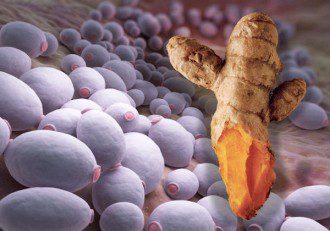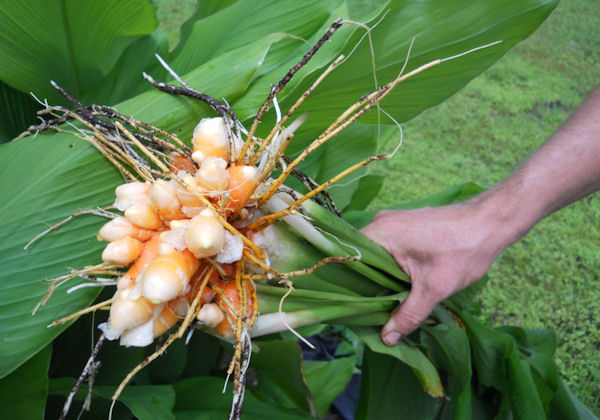By Sayer Ji
Contributing Writer for Wake Up World
A new study validates a controversial cancer theory, namely, that yeast in our body can contribute to not just feeding but actually causing cancer. Can the ancient healing spice turmeric come to the rescue?
A recent study published in Critical Reviews in Microbiology lends support to the concept that opportunistic Candida albicans (yeast) infection may not just be a consequence of cancer, but is an actively contributing cause as well.
Titled, “Candida albicans and cancer: Can this yeast induce cancer development or progression?“, the study provided the following important background information on this controversial subject:
[pro_ad_display_adzone id=”110028″]
“There is currently increasing concern about the relation between microbial infections and cancer. More and more studies support the view that there is an association, above all, when the causal agents are bacteria or viruses. This review adds to this, summarizing evidence that the opportunistic fungus Candida albicans increases the risk of carcinogenesis and metastasis. Until recent years, Candida spp. had fundamentally been linked to cancerous processes as it is an opportunist pathogen that takes advantage of the immunosuppressed state of patients particularly due to chemotherapy. In contrast, the most recent findings demonstrate that C. albicans is capable of promoting cancer by several mechanisms, as described in the review: production of carcinogenic byproducts, triggering of inflammation, induction of Th17 response and molecular mimicry. We underline the need not only to control this type of infection during cancer treatment, especially given the major role of this yeast species in nosocomial infections, but also to find new therapeutic approaches to avoid the pro-tumor effect of this fungal species.”
The four distinct ways by which Candida albicans may contribute to cancer are explained in more detail below:
-
Production of carcinogenic byproducts: First, Candida Albicans produces nitrosamines, which are carcinogens that activate specific proto-oncogenes that could trigger cancerous lesions. Second, Candida albicans produce acetaldehyde, which is produced as the first metabolite of ethanol (the yeast fermentation byproduct), and which is a DNA-damaging (mutagenic) and carcinogenic chemical with a wide range of downstream cancer promoting properties.
-
Triggering of inflammation: Prolonged, unresolved inflammation can promote cancer, both by causing damage to tissue, and through the secretion of proliferative chemicals intended to stimulate regeneration of damaged tissue, but which can render tissue immortalized when the inflammation is chronic and misdirected. Candida albicans is well known to promote a cascade of inflammatory responses within the body when growing beyond their normal population density due to immunosuppression, an inappropriate diet, and/or chemical exposure. These misguided inflammatory responses have been found to promote increases in tumor cell adhesion, which is believed to promote the formation of secondary tumors and/or metastasis.
-
Induction of Th17 response: The set of CD4 T-cells that are dominant in response to Candida albicans, namely, TH17 cells, also secrete factors that may promote angiogenesis (the formation of new blood vessels) and increased tumor incidence and growth.
-
Molecular mimicry: Antibodies produced against a protein on the surface of Candida Albicans (CR3-RP) has structural and antigenic similarities with a receptor on certain of our white blood cells (leukocytes). This “molecular mimicry” may cause antibodies to be formed against our immune cells that then disturb the anti-tumor and anti-Candida defenses of the host.
This newly identified research not only substantiates the concept that yeast overgrowth can be a contributing cause of cancer, but it also, indirectly, raises a red flag to both sugar and alcohol consumption. Clearly, if sugar and its conversion to ethanol produce acetaldehyde, reducing excessive consumption of either is a good chemopreventive step, and likely a completely necessary intervention when actively treating already established cancers — that is, if the goal is full remission.
Moreover, sugar has also recently been found to not just feed cancer, but actively contributes to the transformation of normal cells into cancerous ones; i.e. sugar is potentially carcinogenic. Read my recent article, “Research Reveals How Sugar CAUSES Cancer,” to learn more.
The implications of this research are profound since sugar also promotes yeast growth, which means that sugar is both directly and indirectly carcinogenic; a fact that is all the more concerning considering cancer treatment wards in major hospitals still give sugar-containing foods and beverages to their patients while being treated, or recovering from treatment.
Turmeric: A One-Two PUNCH
A new study published in the European Journal of Pharmacology reveals that the primary polyphenol in turmeric known as curcumin may be the perfect way to fight cancers that have a fungal component.
Titled, “Curcumin and its promise as an anticancer drug: An analysis of its anticancer and antifungal effects in cancer and associated complications from invasive fungal infections,” the new study addressed the concerning problem of invasive fungal infections, as a major cause of both morbidity and mortality, in cancer patients. According to the study, “Effective anti-infection therapy is necessary to inhibit significant deterioration from these infections. However, they are difficult to treat, and increasing antifungal drug resistance often leads to a relapse.” The authors suggest curcumin might offer an ideal natural alternative:
Curcumin, a natural component that is isolated from the rhizome of Curcuma longa plants, has attracted great interest among many scientists studying solid cancers over the last half century. Interestingly, curcumin provides an ideal alternative to current therapies because of its relatively safe profile, even at high doses. To date, curcumin’s potent antifungal activity against different strains of Candida, Cryptococcus, Aspergillus, Trichosporon and Paracoccidioides have been reported, indicating that curcumin anticancer drugs may also possess an antifungal role, helping cancer patients to resist invasive fungal infection related complications. The aim of this review is to discuss curcumin’s dual pharmacological activities regarding its applications as a natural anticancer and antifungal agent. These dual pharmacological activities are expected to lead to clinical trials and to improve infection survival among cancer patients.”
The study went on to explain that conventional therapies often result in collateral damage to the patient’s immune system, which contributes to fungal overgrowth.
Also, conventional drugs for fungal infections can cause serious harm to the liver and kidneys of patients, along with leading to the development of even more aggressive, treatment-resistant fungal infections.
Moreover, conventional cancer treatments only target one aspect of cancer, focusing on a single pathway or molecule on a cancer cell. This is why curcumin holds so much more promise as a “next generation multipurpose drug.” Not only does it combat fungal infections, but it has the ability to address a multitude of cancer targets, including being able to destroy the cancer stem cell subpopulation which is at the root of cancer malignancy and recurrence.
The study concluded:
Curcumin is an up-and-coming drug of natural origin with multi-target properties, and it has exhibited efficient anticancer and antifungal activities alone or in combination with conventional chemotherapy drugs and antifungal agents. The dual pharmacological activities of curcumin may make it a good candidate for the prevention and treatment of cancer and its cancer-related invasive fungal infection related complications. Further investigation is necessary to clarify curcumin’s anticancer and antifungal mechanisms for better understanding. In spite of the useful biological activities of curcumin, its poor water solubility and low bioavailability hinders its clinical applications. Various nano-sized curcumin delivery systems, such as nanoparticles, nanospheres, solid lipid nanoparticles, micelles, and liposomes have been shown to overcome these shortcomings and significantly improve the anticancer and antifungal activities of curcumin. Many studies on curcumin and its nanoformulations are still in the preclinical stage at present. A clinical trials stage is necessary to unlock the potential of curcumin nanoformulations as a therapeutic strategy for treating cancer and its IFI complications.”
Truly, curcumin is fast becoming the most extensively researched and most promising herb for disease prevention and treatment known, with at least 750 studied potential therapeutic applications. To learn more visit our Turmeric’s Research database. For more research on natural substances which combat Candida Albicans infections visit our database on the topic.
Previous articles by Sayer Ji:
- Better Than Chemo: Turmeric Kills Cancer Not Patients
- Mammography Is Harmful and Should Be Abandoned, Scientific Review Concludes
- Cinnamon May Be Superior to Ibuprofen for Menstrual Pain, Study Reveals
- “Killer Germs” Obliterated by Medicinal Smoke Smudging, Study Reveals
- Coconut Water: A New Alzheimer’s Disease Treatment?
- Turmeric’s ‘Smart Kill’ Properties Put Chemo & Radiation To Shame
- 6 Evidence-Based Ways Drumming Heals Body, Mind and Soul
- Tylenol Kills Emotions As Well As Pain, Study Reveals
- Research: Plants Cure Cancer, Not Chemicals
- Beet Juice Boosts Cognitive Function In One Dose
- 13 Evidence-Based Medicinal Properties of Coconut Oil
- 25 Cancer Stem-Cell Killing Foods That Are Smarter Than Chemo and Radiation
About the author:
 Sayer Ji is on the Board of Governors for the National Health Federation and Fearless Parent, Steering Committee Member of the Global GMO Free Coalition (GGFC), a reviewer at the International Journal of Human Nutrition and Functional Medicine, and founder of GreenMedInfo.com – an open access, evidence-based resource supporting natural and integrative modalities.
Sayer Ji is on the Board of Governors for the National Health Federation and Fearless Parent, Steering Committee Member of the Global GMO Free Coalition (GGFC), a reviewer at the International Journal of Human Nutrition and Functional Medicine, and founder of GreenMedInfo.com – an open access, evidence-based resource supporting natural and integrative modalities.
In 1995 Sayer received a BA degree in Philosophy from Rutgers University, where he studied under the American philosopher Dr. Bruce W. Wilshire, with a focus on the philosophy of science. In 1996, following residency at the Zen Mountain Monastery in upstate New York, he embarked on a 5 year journey of service as a counsellor-teacher and wilderness therapy specialist for various organizations that serve underprivileged and/or adjudicated populations. Since 2003, Sayer has served as a patient advocate and an educator and consultant for the natural health and wellness field.
Visit GreenMedInfo online and on Facebook, or sign up for GreenMedInfo’s e-Newsletter.
[pro_ad_display_adzone id=”110027″]








